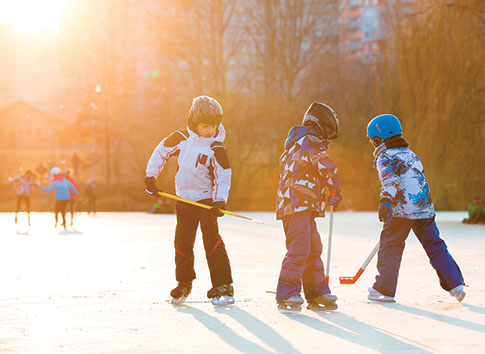Home skating rinks: Get into the game!

A backyard skating rink is a fantastic way to get the most out of winter. Here are some things to bear in mind to make sure you get off to a good start.
Dreaming about teaching the kids to skate or inviting a few friends over to play shinny? The first thing to do is find the perfect spot for it. You’ll need that spot to be at least 8 feet by 16 feet if it’s just for skating and 16 feet by 40 feet if you’re hoping for some fast and furious hockey action too. Allow an extra 2 to 4 feet around the rink as well, so you’ll have somewhere to shovel the snow. CAA-Quebec residential advisor Jacques Laliberté suggests a spot near a tap, so it’s easier to water. Look for a flat concrete or grass surface that’s partly in the shade. And if you want to have lights for skating after dark, you should try to be near a power outlet.

Mark out the borders and prepare the base
If you’ve decided to go with grass, start with a sheet of polyethylene big enough to cover the whole surface. You can use the boards of your rink to keep it in place or pack snow around the edges. If you’re planning on playing hockey, you’ll want wooden boards all around your rink. Otherwise you can pack snow around the ice surface. Pile it up at least 2 feet high, to serve as boards. To get the surface ready for flooding, pack about 10cm (4 inches) of snow where the ice is going to go with a lawn roller or shovel, then flatten it out.
Make and care for the ice
Jacques Laliberté recommends using a garden hose with an adjustable nozzle for spraying the base layer. The warmer it is, the finer the spray has to be and the less water you can put on. Spray crosswise in strips. Once you’ve sprayed a thin layer over the whole rink, leave the ice to harden for 2 to 4 hours before spraying it again. Repeat as many times as it takes to get the ice 6 to 10cm thick. When is the right time to get started? Wait till the temperature falls below −10°C for two nights in a row. And when you’re done and satisfied that the rink has brightened up your backyard, don’t forget to maintain it. Clean the ice after every skate or snowfall. Fill in any holes with snow, not water. Laliberté also recommends re-flooding the rink a few times each winter, first smoothing out the ice and then flooding it to a depth of 4mm. Note that if you can use warm water, you’ll get harder ice.

Let your insurance provider know about to avoid nasty surprises
Suzanne Michaud, CAA-Quebec Vice President, Insurance, will tell you it’s best to let your insurance provider know about your backyard skating rink. It only takes a few minutes to make sure you’d be covered if anything were to go wrong. If a skater is injured and manages to prove negligence on your part, the liability component of your home insurance covers injury to other people. If you’re worried about your pipes freezing because you couldn’t shut your outdoor tap off for the winter, get an “all perils except” policy that covers you for that. And don’t worry about flooding when your rink melts in the spring. According to Michaud, the risks are minimal. “A really thick skating rink might be maybe 10cm thick,” she says, “and that’s the equivalent of only 15mm of water. Any heavy rainfall will produce more rain than that. And of course your rink won’t melt away in a couple of hours. It is however true that any damage to your yard or landscaping your rink causes won’t be covered by your home insurance.”
Can I go out on the ice?
Thinking of a skate on the lake next time you’re out at the cottage? Before you step out, best make sure the ice is thick enough. You can find out from the local authorities or drill small holes in the ice in various places. The Quebec Lifesaving Society says that ice 10cm (4 inches) thick is safe to walk or skate on, but ice less than 7cm thick (3 inches) is dangerous.

Benefit from personalized advice
Do you have questions about your home, need specific information, or are you looking for referrals to find an Approved Supplier?